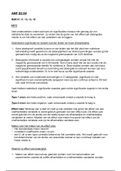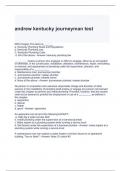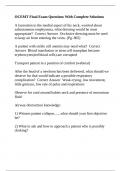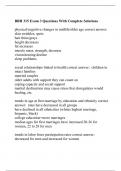ONE PAGE DOUBLE SIDED A4 CONTAINING THE WHOLE MODULE
Contents
1. Define the Hssue and organ levels of organisaHon.
2. Describe the structure & funcHon of epithelial, connecHve Hssue and membranes.
3. Name the components of the respiratory system and summarise their funcHons.
4. Describe the mechanism of pulmonary venHlaHon.
5. Outline how respiratory gasses are transported in the blood.
6. Describe the components of and funcHons of blood including plasma, red blood cells,
white blood cells and platelets.
7. IdenHfy the main structures of the heart and relate to cardiac funcHon and the cardiac
cycle.
8. Describe the flow of blood through the heart, idenHfying the major blood vessels,
chambers and heart valves.
9. Describe the components and funcHons of the conducHng system of the heart.
10. IdenHfy the components of the circulatory system and describe their structure and
funcHon.
11. Name and describe the major components and funcHons of the urinary system.
12. Describe the structure of the kidney and explain the basic principles of nephron
transport and urine formaHon.
13. Describe the voluntary and involuntary regulaHon of urinaHon.
14. Describe the structure of the alimentary canal and organs of the GI system.
15. Describe the basic funcHons of the GI system and the processes of digesHon, absorpHon and
eliminaHon.
16. List and describe the funcHons of the skeleton and describe the structure of bones.
17. Name the bones of the axial and appendicular skeleton.
18. Describe the structure of muscle and outline how muscles contract.
19. Describe the structure of the sarcomere and relate the organisaHon of myofilaments to the sliding
filament theory.
20. Define the divisions of the nervous system.
21. Describe the components of, and funcHonal organisaHon of the nervous system.
22. Describe acHon potenHals and synapHc transmission.
23. Name and locate the endocrine glands and idenHfy their principle hormones.
24. Review the modes of acHon of hormones.
25. Describe and compare endocrine, paracrine and neural cell communicaHon.
26. Describe the structure and funcHon of the organs of the reproducHve system in males
and females.
27. Outline the principles of homeostasis, describe the control systems and explain
feedback mechanisms.
28. Describe the underlying pathology of a named disease in each of the body systems
(respiratory, cardiovascular, renal/urogenital, digesHve, musculoskeletal, nervous and
endocrine/reproducHve)
BSC BIOMEDICAL SCINCE
UNIVERSITY OF ESSEX
FONT: Calibri Size 5 (≈ 10,000 words)







